In this blog post, we introduce our new Aerial Elo Rating Optimization (AERO) index, a new metric focused on aerial skill.

Aerial skill metrics and the case for an Elo rating
Aerial duels can be a key event in football on both ends of the pitch, and the relative skill between defenders and forwards in this area can dictate the tactical approach a team decides to employ against a specific opponent. For example, suppose the coach knows that their forwards do not have great chances of winning aerial duels with the opposition defenders in one particular matchup. In that case, they may instruct the team to avoid playing many long balls and crosses.
The most straightforward metric to evaluate aerial skill is the total aerial duel win percentage, which does provide useful insights if there are enough duels for it to be significant. However, it suffers from two main drawbacks:
- It does not differentiate between offensive and defensive duels
- It does not take into account the matchup of aerial skills of the two players in each duel, i.e., a duel won counts the same whether it is against a player who is strong in the air or not
The first issue could be solved by computing a separate aerial win percentage for offensive and defensive duels, but the second one would require a most sophisticated approach. Since aerials are one of the few events in football that can be treated as a true individual duel between two players, they are a good use case for an Elo rating system. Initially developed for chess, Elo ratings have since been applied to other sports. In football, they are used to compute the FIFA ranking for national teams based on match results.
Elo ratings take the same initial value for all players and then are updated based on the result of each duel and the ratings of the two players involved. If player A wins a duel against a lower-rated player B, they will add a relatively limited amount of points to their rating, since they were expected to win, and player B will see an equally limited reduction in their rating. However, if player A wins a duel against a higher-rated player B, their rating will have a higher gain, and player B’s rating will take an equally bigger loss since they were expected to win. This allows us to:
- Put each duel into context using the skill level of the two players
- Predict a win probability for individual duels, even if the two players have never faced each other
- Track a player’s performance over time
Separate ratings can be computed for offensive and defensive duels so that we can address both limitations of total aerial win percentage.
One of the main limitations of this method is data coverage. In our case, our event data coverage starts from season 2017/18 for the top 5 European leagues, and from season 2020/21 (or 2020) for all the other leagues in our platform.
How do we calculate our ratings?
We can compute offensive and defensive aerial Elo ratings from event data. We start by assigning all players the same initial rating of 1000. We then take all aerial duels, including aerial fouls (in this case, the player committing the foul loses the duel), and exclude those involving goalkeepers. Naturally, each duel will be offensive for one of the two players and defensive for the other.
We can then update the two ratings separately processing each duel in chronological order so that the up-to-date rating is used in each one. For any duel, given player A and player B, we define an expected score for player A, which will be a number between zero and one, depending on the difference between the ratings of the two players. The two bounds (0 and 1) are limit cases that can’t occur in real data, corresponding to when player B has an infinitely higher rating than player A, and vice versa. The expected score for player B will simply be the reciprocal, i.e. one minus the expected score for player A. The ratings are then updated based on the difference between the actual result (1 for the winning player, 0 for the losing player), multiplied by a constant factor (usually indicated with K), which we set at a commonly used value of 32.
For example, if player A has a rating of 1100 and player B has a rating of 900, the expected scores will be 0.76 and 0.24, respectively. If player A wins, they will increase their rating by K * (1 – 0.76) = 7.69, so the new rating for player A will be 1107.69, while the new rating for player B will be 900 + K * (0 – 0.24) = 900 – 7.68 = 892.32. The larger the difference between expected and actual results, the higher the impact of the individual duel on the players’ ratings. For example, if player B would have won the duel as an underdog, then their rating would have increased by 24.32, and player A’s rating would have decreased by the same amount. Naturally, in the case where the duel is offensive for player A, their offensive rating will be updated, while player B will see their defensive rating updated. We repeat this process for the hundreds of thousands of aerial duels in our database, updating the players’ ratings at each step until we obtain the current value of the two ratings for each player. To convert the metric into a more intuitive range of values, we express it in terms of the probability of winning an aerial duel against an average-rated player, with a final number between 0 and 100, which we refer to as AERO index. If the value is above 50, the player’s aerial performance is above average, and vice versa.
Results: highest-rated players
Here we show the top 20 players in the top 5 leagues for defensive and offensive AERO, with at least 100 duels, including an indication of the number of duels and win percentage, as well as their latest team on our records. We can see that the rankings look quite different, justifying the choice of computing a separate one for offensive and defensive duels. In fact, only three players (Marcelo, Tarkowski, Zouma) appear in both top-20 lists. It is also interesting to note how AERO can deviate from win percentages in identifying top performers, as in the case of Terrier, 2nd-ranked for offensive rating despite a win percentage slightly below 50%. We will discuss the relation between ratings and win percentage in more depth later, but this is a good example of the importance of accounting for the opponent in each duel, and not only the result.
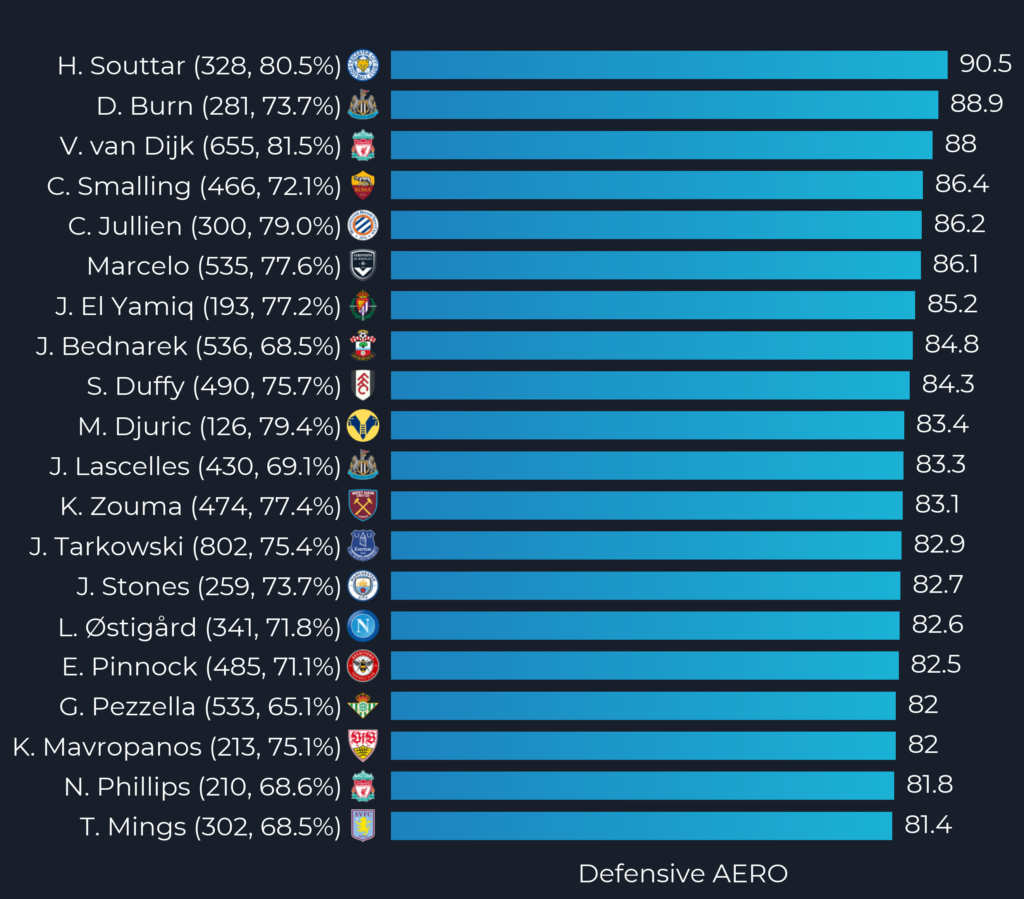
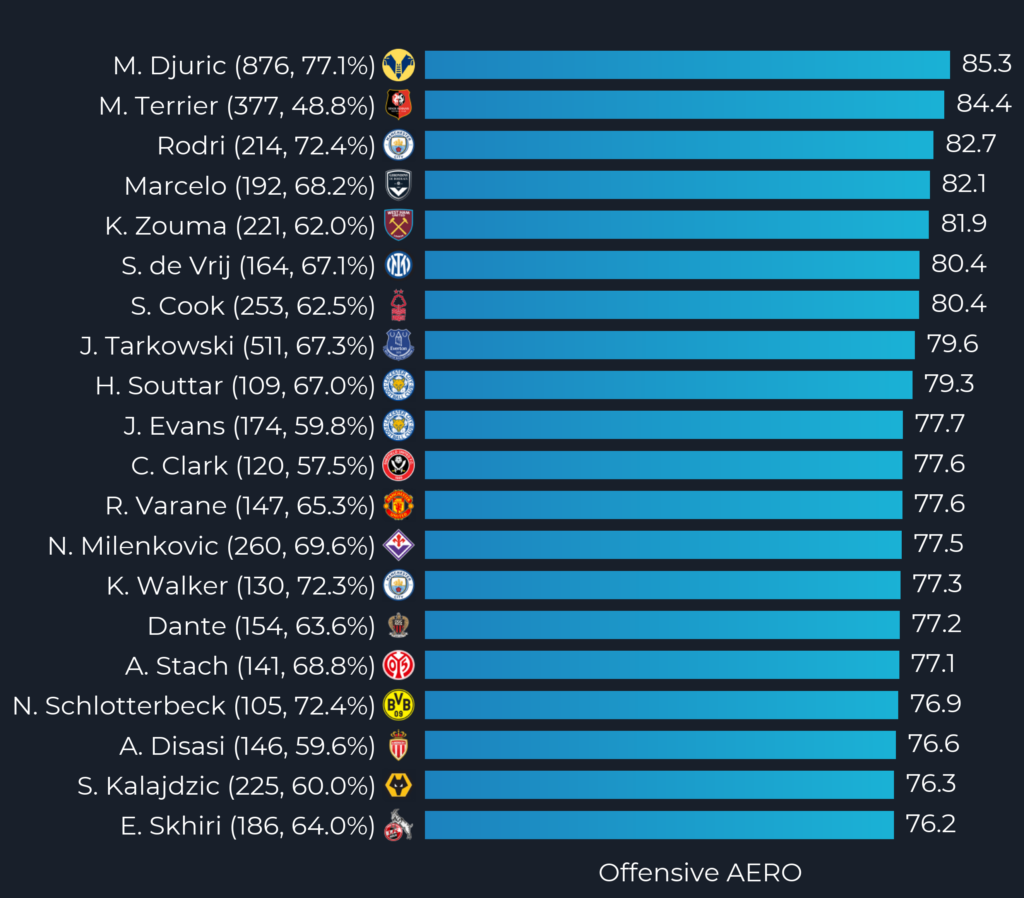
We can also use AERO to find the top-rated young players, filtering for those born after 01-01-2002 with at least 100 aerial duels, widening the search to all the leagues in our coverage.
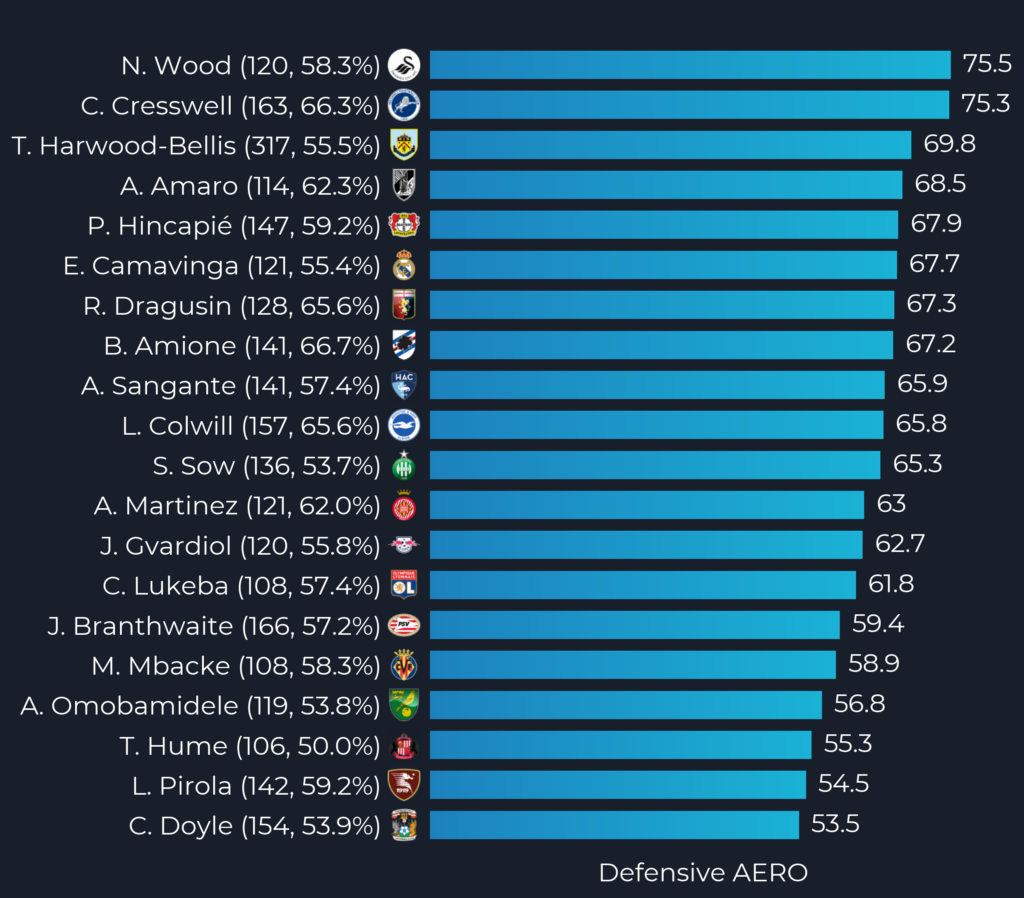
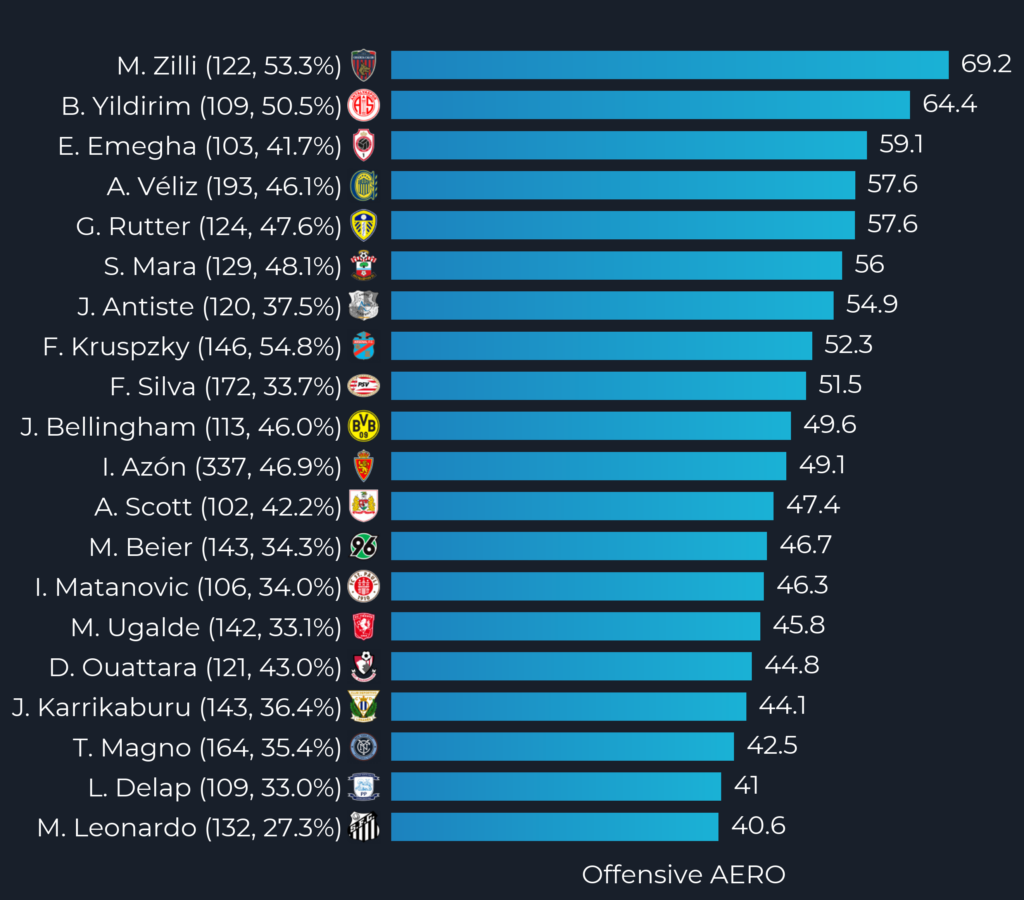
We can see how the top players’ skill tracks over time by looking at the evolution of their rating with each aerial duel, highlighting the underlying trend with a moving average. If we look at the top-ranked player in the top 5 leagues for defensive duels, Leicester’s Harry Souttar, we see that his defensive aerial skill has been gradually improving over the years, suggesting that he could get even better despite already being at the top of the ranking, as he is still relatively young (24).
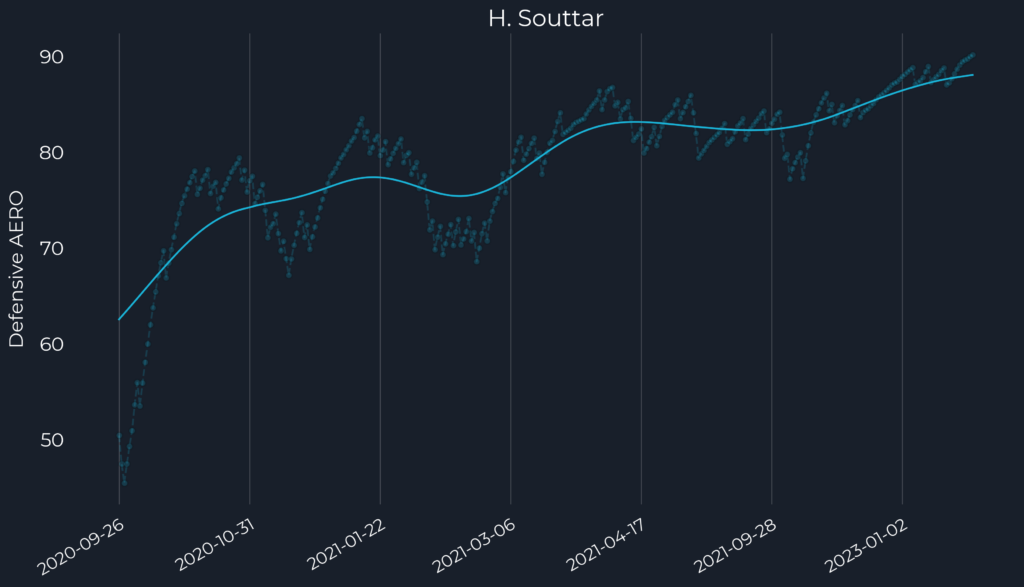
The top-ranked player for offensive aerial skill is Verona’s Milan Djuric. As a more experienced player (33) his performance has been more stable.
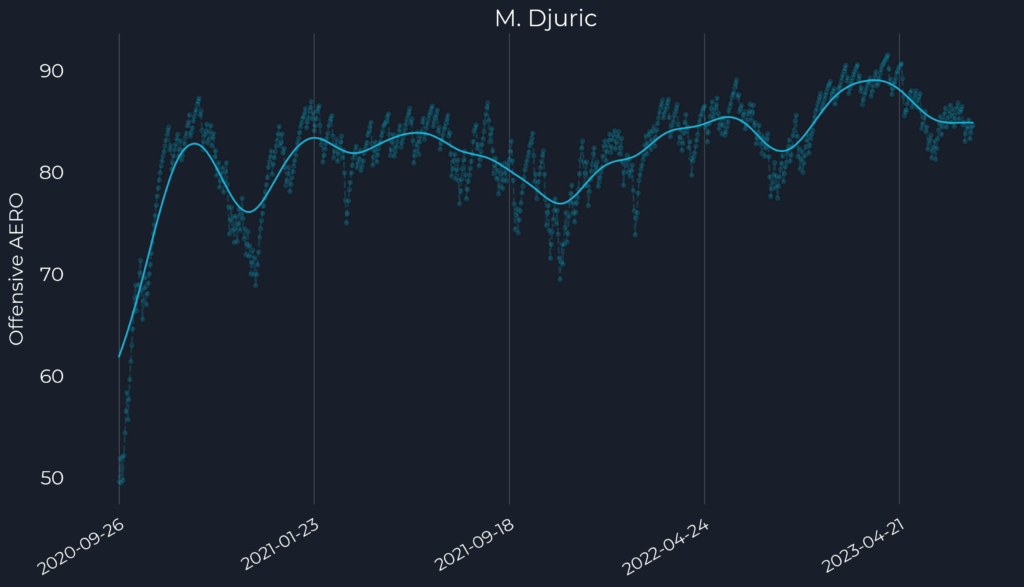
We can also look at the case of Terrier, which we highlighted above due to the discrepancy between his offensive rating and the corresponding win percentage. His rating evolution shows that while his aerial performance was indeed average for several seasons, his rating has been on a strong upward trajectory in recent times. In fact, his offensive aerial win percentage starting from season 2021/22 is 58.5%, significantly higher than the full average. Future results will tell if these improvements are here to stay when the 26-year-old returns from an ACL injury that prematurely ended his 2022/23 season in January 2023.
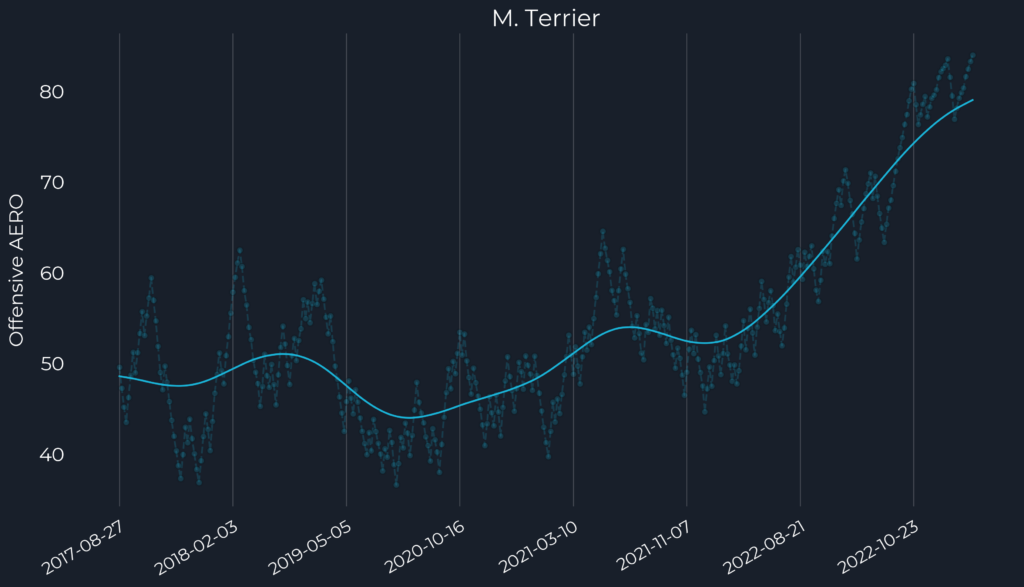
These graphics highlight once more that the Elo method depends on data coverage, as it requires a minimum number of observations for a player’s rating to converge to a somewhat stable value. Looking into the individual players’ timeline of aerial duels, we find that for 90% of players with at least 100 duels, it takes between 10 and 20 duels for their rating to reach within a standard deviation of the average value.
AERO, win percentage, and player height
As we mentioned above, while we believe that AERO goes a step beyond win percentage as a metric of aerial skill, the latter is still a useful first-order indicator, and therefore we expect it to have a significant level of correlation with any good aerial skill metric. We can see the relation between AERO and win percentage in the two scatter plots below, showing all players with at least 20 duels (defensive or offensive, respectively). The two metrics are clearly well correlated (Spearman’s correlation coefficients are 0.82 and 0.80, respectively), with a reasonable amount of outliers.
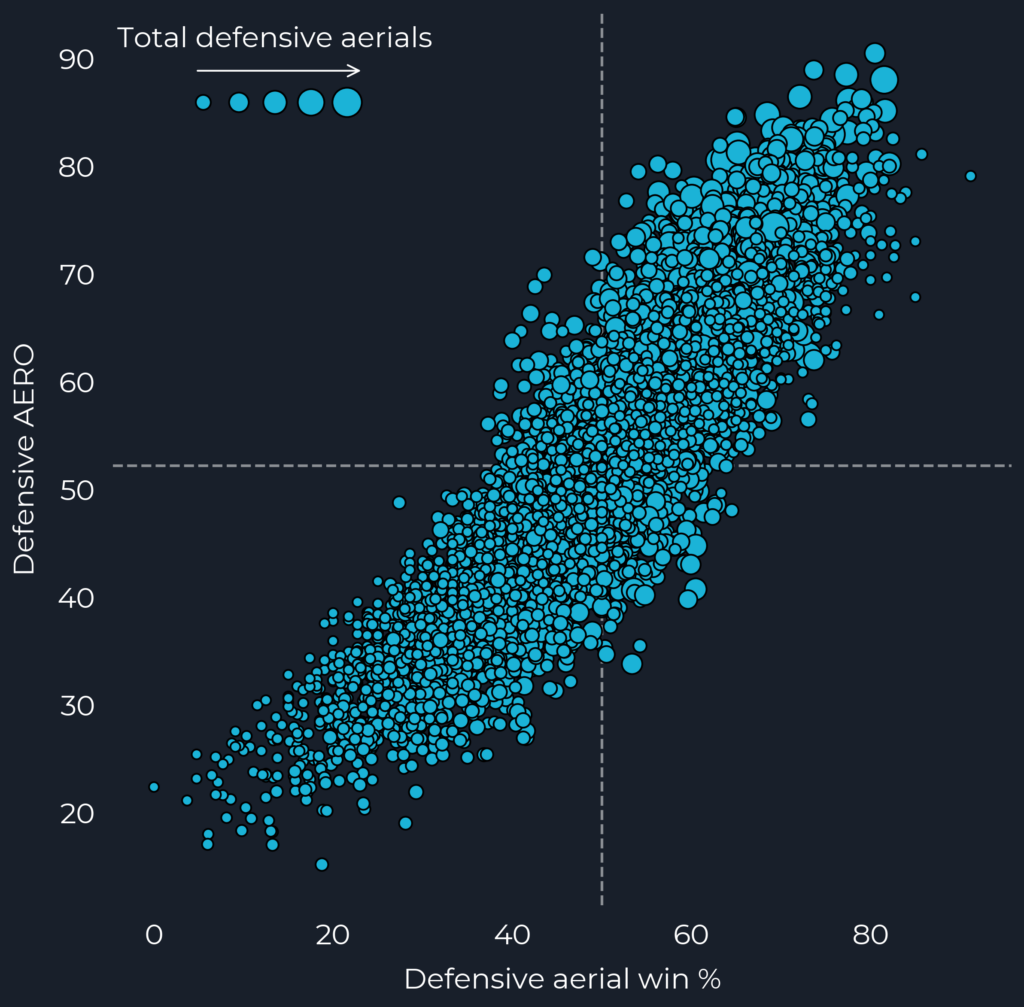
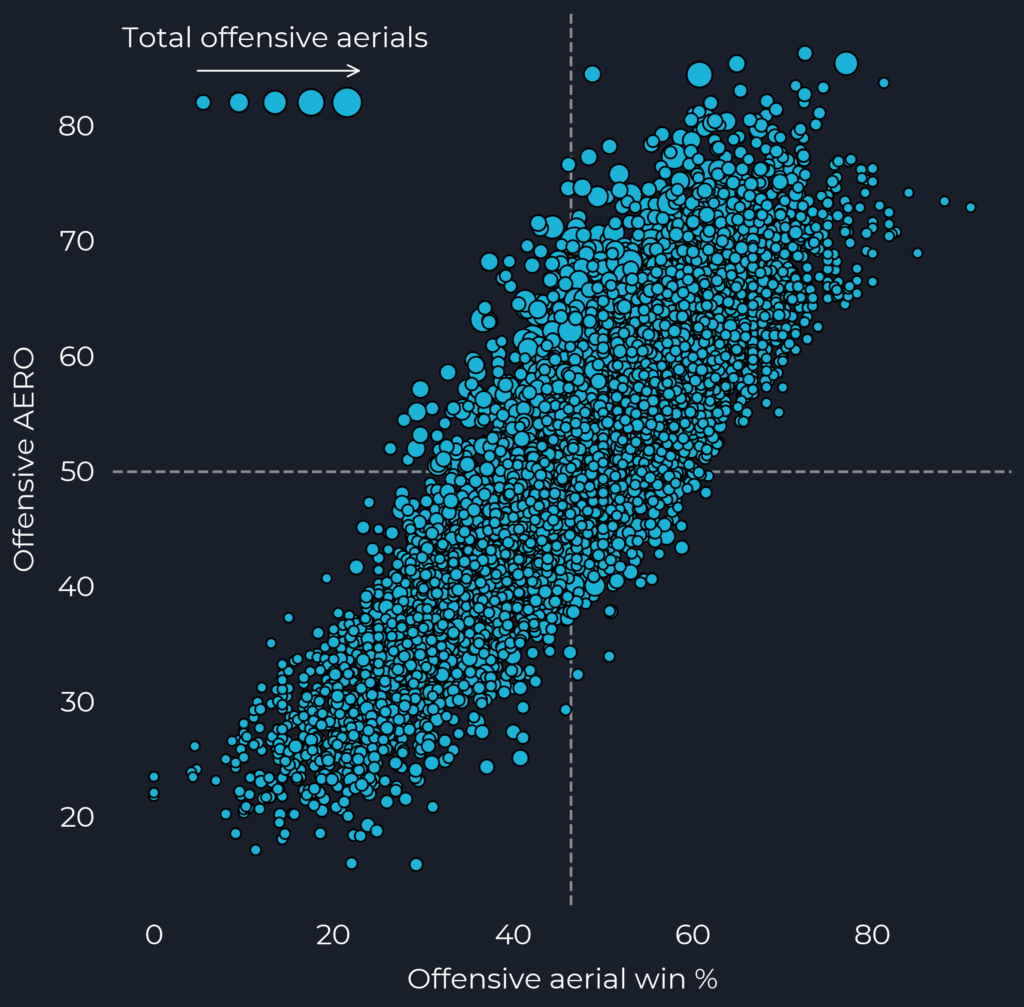
We also note that the median is lower for offensive duels than for defensive ones for both win percentage (42.6% vs. 53.6%) and AERO (49.2 vs 50.4), with a significantly more pronounced difference (in relative terms) for the former. This can be understood in football terms, since retaining possession in an attacking duel is harder than preventing the opponent from retaining possession, i.e. the defending player has a certain advantage. This is the main reason why we chose to compute separate ratings, and the fact that the relative difference between them is reduced compared to the difference in win percentage shows that the system goes some way toward addressing this point.
Player height is another parameter for which it is worthwhile to look at possible correlations with our aerial ratings, as taller players may naturally be expected to perform better in aerial duels. This is indeed the case: player height correlates with both defensive and offensive AERO. However, the correlation is not as strong as one might expect, with Spearman’s correlation coefficients of 0.46 and 0.43, respectively. Notable positive outliers for defensive aerials are Leo Østigård (Napoli, 1.82m, AERO 82.6), Grant Hall (Rotherham, 1.75m, AERO 83.6), and Zinchenko (1.75m, AERO 76.5), while on the negative side, we find Busquets (1.89m, AERO 43.1) and Marius Wolf (B. Dortmund, 1.88cm, AERO 33.5). On the offensive side, as positive outliers, we find Lucas Moura (1.72m, AERO 67.2), Tyler Adams (1.73m, AERO 61.8), and Wijnaldum (1.75m, AERO 63.8), while on the other side, we find Josip Ilicic (1.90m, AERO 20.0), Stipe Perica (Standard Liege, 1.92m, AERO 24.0), and Henk Veerman (Volendam, 2.01m, AERO 48.5).
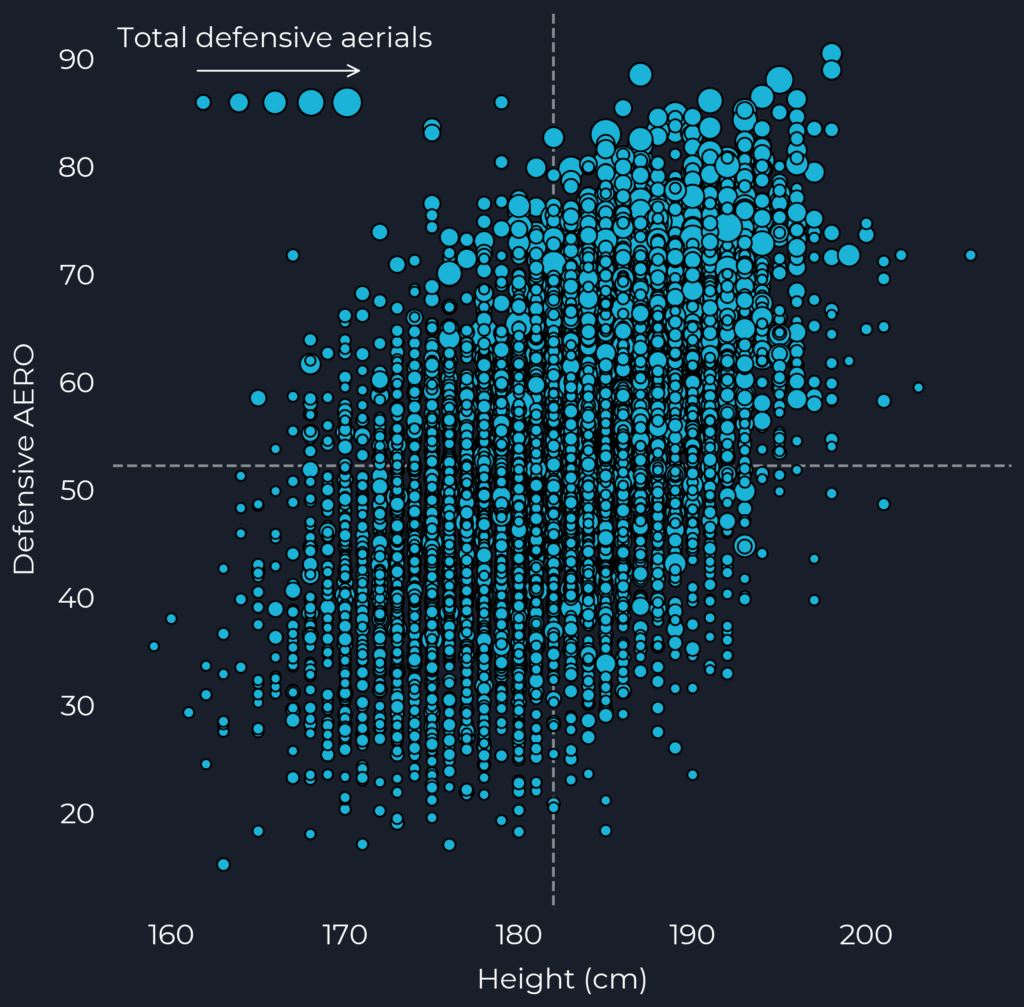
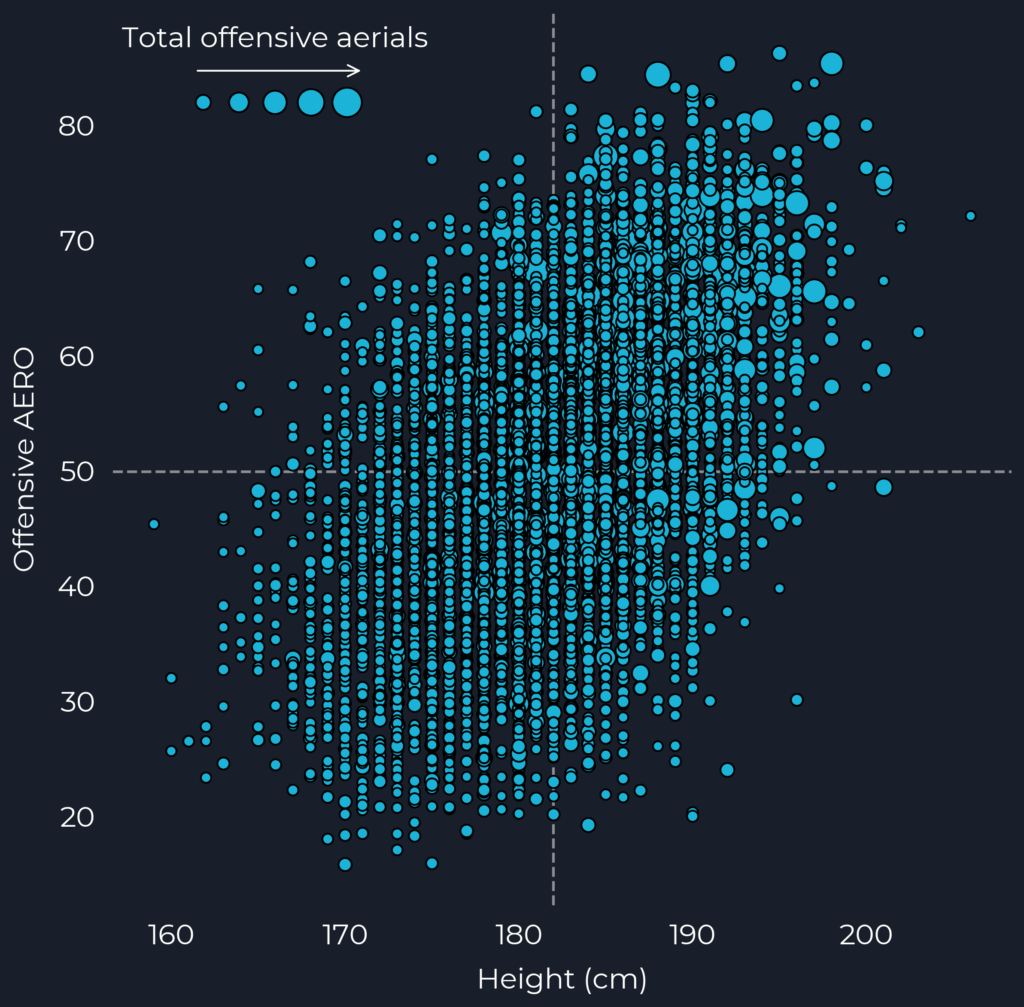
Team average values
We can also have an idea of which teams in the top 5 leagues have the right players in their roster to be dominant in aerial duels, by taking a weighted average of the players’ AERO, with the number of duels as weight.
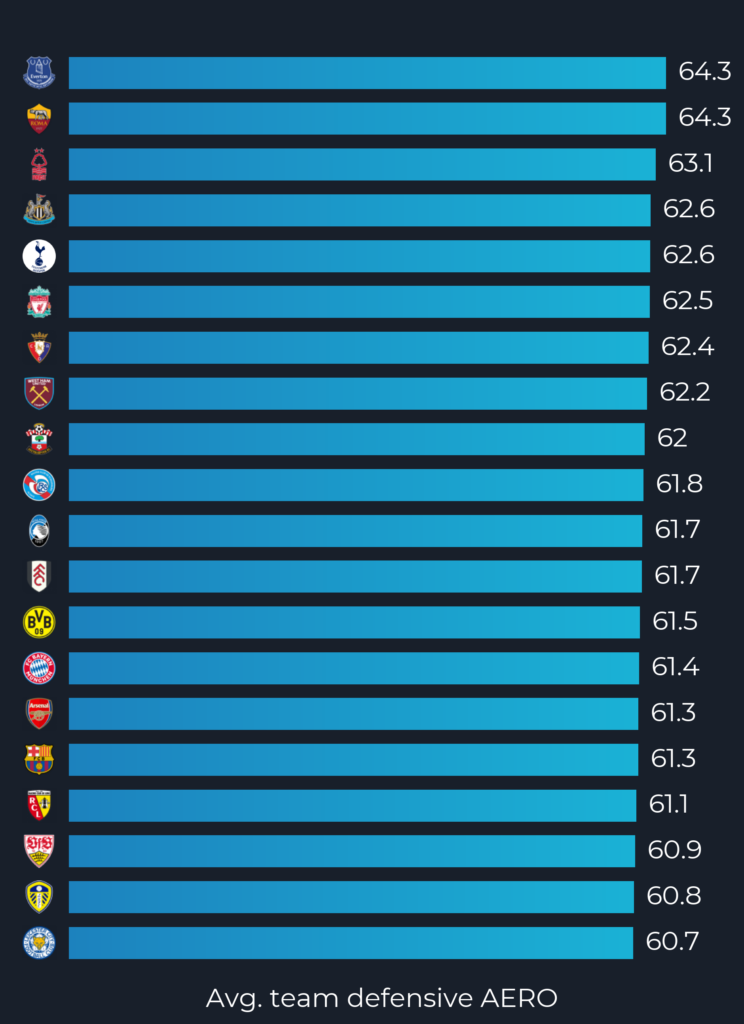
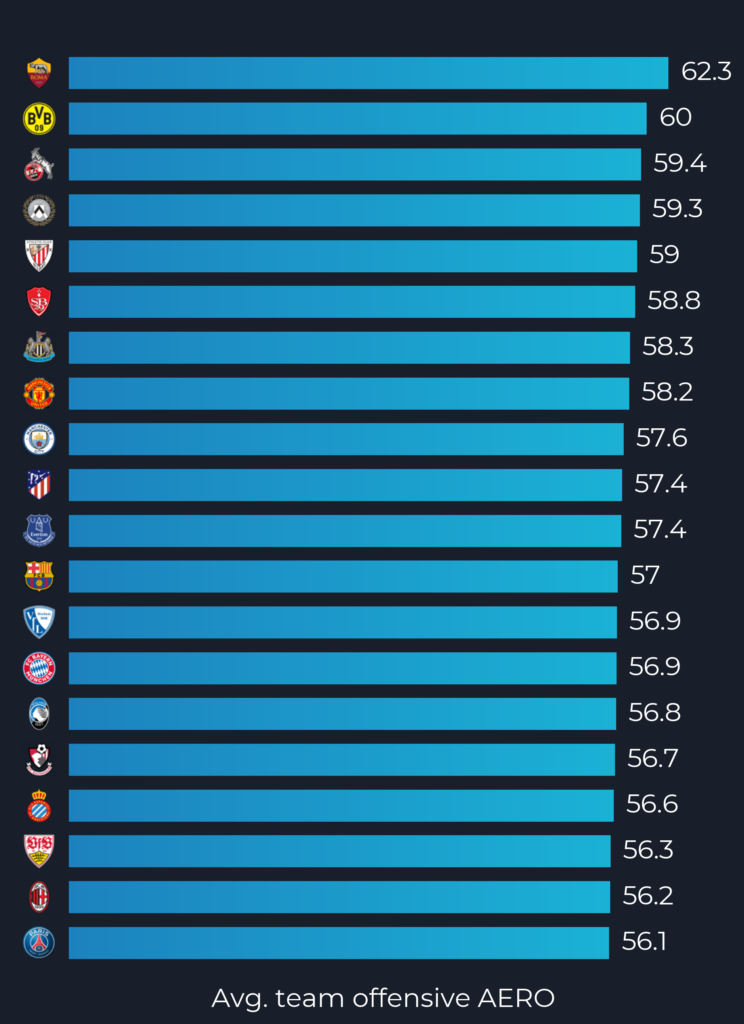


Leave a Reply